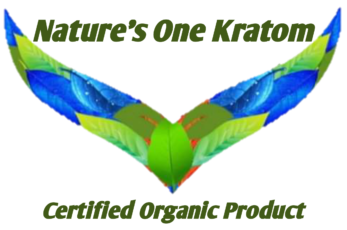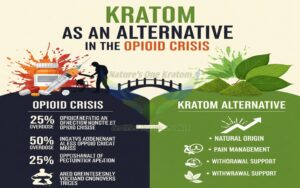No products in the cart.

Kratom, a tropical tree native to Southeast Asia, has gained attention for its potential in managing opiate withdrawal symptoms and pain relief. As the opioid crisis continues to affect millions worldwide, researchers and individuals alike are exploring alternative methods to address addiction and chronic pain. Kratom’s unique properties have sparked interest in its use as a natural remedy, prompting discussions about its effectiveness and safety.
Recent studies have begun to shed light on kratom’s complex interactions with the human body, particularly its impact on opioid receptors. This research has led to growing curiosity about kratom’s potential to help individuals struggling with opiate withdrawal. Additionally, the plant’s pain-relieving properties have attracted those seeking alternatives to traditional pain management techniques. As the debate surrounding kratom’s use continues, it’s crucial to examine the scientific evidence, compare it to established treatments, and consider its possible therapeutic applications.
The Science Behind Kratom
Alkaloids in kratom
Kratom contains a complex mixture of alkaloids, with over 40 compounds identified to date . The most prevalent and well-studied alkaloids are mitragynine and 7-hydroxymitragynine (7-HMG) . Mitragynine accounts for approximately 2% of kratom preparations by mass and up to 66% of the total alkaloid content . 7-HMG, a highly active metabolite of mitragynine, is present in much lower quantities, generally under 0.02% . Other significant alkaloids include speciogynine, paynantheine, and mitraphylline .
Interaction with opioid receptors
Kratom alkaloids interact with opioid receptors, but in a manner distinct from traditional opioids . Mitragynine and 7-HMG target μ-, δ-, and κ-opioid receptors with varying affinities . 7-HMG has shown a higher potency than mitragynine and morphine, with an affinity approximately 46 times that of mitragynine and 13 times that of morphine .
Research has revealed that kratom alkaloids act as mixed opioid receptor agonists/antagonists. They behave as partial agonists at μ-receptors and competitive antagonists at δ-receptors, with minimal effects on κ-receptors . This unique interaction profile has led to kratom alkaloids being classified as “atypical opioids” .
Pharmacological effects
The pharmacological effects of kratom are multifaceted, extending beyond opioid receptor interactions. Mitragynine has shown to have the following effects:
1. Analgesic properties: Mitragynine exhibits multimodal pain-relieving effects through opioid and non-opioid mechanisms.
2. Adrenergic activity: It activates α-2 adrenergic postsynaptic receptors, contributing to pain modulation.
3. Anti-inflammatory effects: Mitragynine has been observed to inhibit COX-2 and prostaglandin E2 mRNA expression [1] https://www.ncbi.nlm.nih.gov/pmc/articles/PMC7203303/.
4. Neuroprotective potential: It has been suggested to modulate the Keap1-Nrf2 pathway and upregulate antioxidant genes.
5. Interaction with other receptors: Mitragynine has shown weak antagonistic action on AMPA and NMDA receptors, as well as activation of GABAB receptors.
Importantly, kratom alkaloids demonstrate biased agonism, selectively activating G-protein-coupled receptor signaling without initiating the β-arrestin pathway. This unique property may contribute to a more favorable side effect profile compared to traditional opioids.
Kratom vs. Traditional Opioid Withdrawal Treatments
Comparison with methadone and buprenorphine
Kratom has gained attention as an alternative to traditional opioid withdrawal treatments, such as methadone and buprenorphine. These FDA-approved medications act on mu-opioid receptors, with methadone functioning as a full agonist and buprenorphine as a partial agonist. Kratom’s primary active ingredients, mitragynine (MIT) and 7-hydroxymitragynine (7-HMG), also interact with opioid receptors, producing analgesic and euphoric effects.
However, kratom’s alkaloids act as partial agonists at mu-opioid receptors, resulting in less intense opioid-like effects compared to full agonists like morphine or fentanyl . This partial activation may reduce the risk of respiratory depression, a potentially life-threatening side effect associated with traditional opioids.
Advantages of kratom
6. Reduced respiratory depression risk: Kratom’s partial agonist activity at mu-opioid receptors may lead to a lower risk of respiratory depression compared to full agonists.
7. Multi-receptor interaction: Kratom alkaloids interact with kappa-opioid and alpha-2 adrenergic receptors, potentially enhancing pain relief and contributing to sedative effects .
8. Self-reported effectiveness: Many users report high rates of effectiveness in managing chronic pain, anxiety, and depression.
9. Potential for opioid replacement: Some individuals use kratom as a natural alternative to physician-supervised opioid replacement therapy .
10. Attenuation of opioid withdrawal: Kratom has been reported to significantly reduce potentially severe opioid withdrawal symptoms .
Limitations and concerns
11. Lack of FDA approval: Kratom is not approved by the FDA for any medical use, and the agency warns against its use due to the risk of addiction, misuse, and dependence.
12. Variability in alkaloid content: Kratom’s alkaloid composition varies based on geographical regions, seasons, and leaf maturity, making standardization challenging .
13. Potential for addiction: Long-term kratom use has been associated with dependence and addiction-like symptoms in humans.
14. Withdrawal symptoms: Users may experience difficulties in combating kratom withdrawal when attempting to cease consumption.
15. Risk of contamination: Commercially available kratom products may contain dangerous contaminants, including heavy metals and harmful bacteria [7] https://www.mayoclinic.org/diseases-conditions/prescription-drug-abuse/in-depth/kratom-opioid-withdrawal/art-20402170.
16. Lack of established treatment protocols: There is no evidence-based consensus for treating kratom addiction and withdrawal, leaving individual providers to determine appropriate courses of action.
17. Potential for overdose: While rare, kratom overdose is possible and may require treatment similar to opioid overdose, including the use of naloxone.
18. Polydrug use concerns: Kratom-related deaths have been predominantly associated with polydrug use, highlighting the risks of combining kratom with other substances.
Potential Therapeutic Applications of Kratom
Kratom, a tropical evergreen tree native to Southeast Asia, has been used for centuries as a traditional herbal remedy. Its potential therapeutic applications have gained attention in recent years, particularly in the areas of managing opioid dependence, chronic pain treatment, and addressing mood and anxiety disorders.
Managing opioid dependence
Research suggests that kratom may be effective in managing opioid dependence by reducing withdrawal symptoms and cravings. The alkaloids found in kratom interact with opioid receptors in the brain, producing effects that range from stimulant-like at low doses to sedative-analgesic at higher doses. This unique interaction profile has led some individuals to use kratom as a natural alternative to physician-supervised opioid replacement therapy.
Mitragynine, a primary alkaloid in kratom, may exert several convergent pharmacological effects that could attenuate opioid withdrawal symptoms and blunt cravings. The National Institute on Drug Abuse (NIDA) and the NIH HEAL Initiative are supporting studies to evaluate kratom and related compounds as potential treatments for opioid withdrawal and opioid use disorder.
Chronic pain treatment
Kratom has shown promise in chronic pain treatment, with some evidence suggesting its effectiveness for this purpose. Several studies have provided evidence for successful self-management of pain using kratom in the United States and Malaysia . The compound 7-hydroxymitragynine, found in kratom, is 13 times more potent than morphine, contributing to its pain-relieving properties.
A case study reported the protracted use of kratom for chronic pain treatment and opioid replacement therapy. Additionally, a recent case report documented kratom use for controlling COVID-19 related symptoms and pain.
Mood and anxiety disorders
Kratom’s potential to treat mood and anxiety disorders has also been explored. Some research indicates that kratom may have mood-enhancing and anxiolytic effects. Preclinical and clinical observations have suggested a potential therapeutic use of kratom for the treatment of depression and anxiety disorders.
In one animal study, researchers determined that kratom lowers corticosterone levels in mice, which may be relevant to its potential antidepressant effects. Early studies suggest that kratom may have antidepressant properties that warrant further investigation.
While these potential therapeutic applications are promising, it’s important to note that kratom has not been proven safe or effective for any medical purpose by regulatory bodies. Further research is needed to fully understand kratom’s efficacy and safety profile in these therapeutic contexts.
Conclusion
Kratom’s potential as a natural remedy for opiate withdrawal and pain relief has sparked significant interest in the medical community. Its unique interaction with opioid receptors and complex alkaloid profile suggest promising applications in managing addiction and chronic pain. However, the lack of FDA approval and concerns about its safety underscore the need for more research to fully understand its effects and establish standardized treatment protocols.
Moving forward, it’s crucial to balance the potential benefits of kratom with its risks and limitations. While some individuals report success in using kratom to manage opioid dependence and chronic pain, its long-term effects and potential for addiction remain areas of concern. To make informed decisions about kratom’s use in medical settings, there’s a need for more comprehensive studies and clinical trials. This research could pave the way for new approaches to tackle the ongoing opioid crisis and provide alternative pain management strategies.
FAQs
Currently, there are no frequently asked questions available related to the effectiveness of Kratom for opiate withdrawal and pain relief. Please check back later for updates.








Add comment